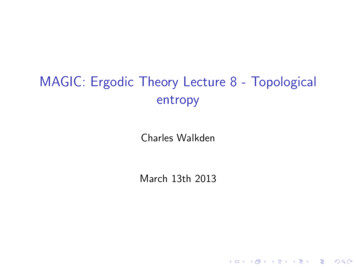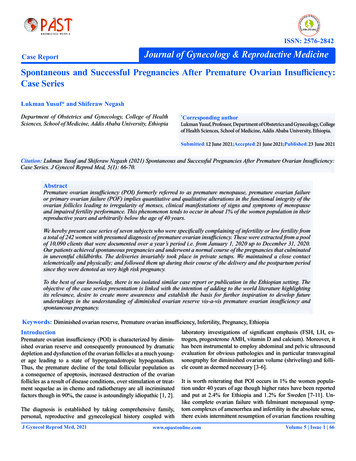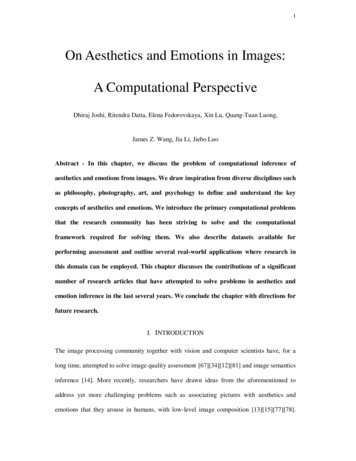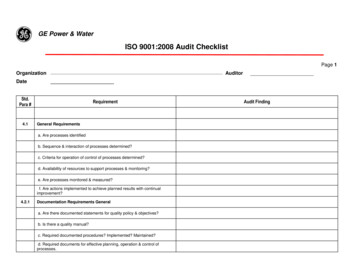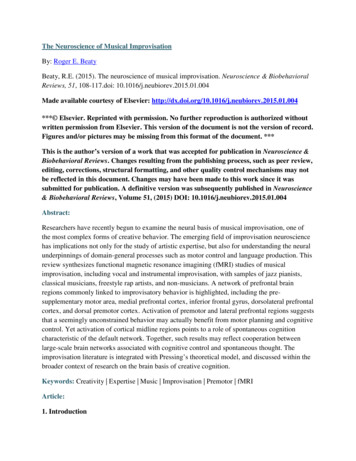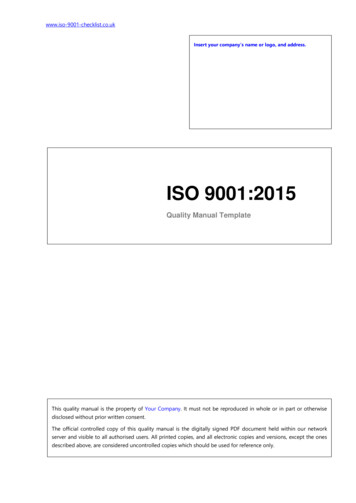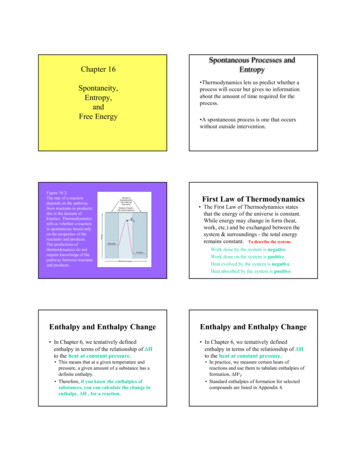
Transcription
Spontaneous Processes andEntropyChapter 16 Thermodynamics lets us predict whether aprocess will occur but gives no informationabout the amount of time required for theprocess.Spontaneity,Entropy,andFree EnergyFigure 16.2:The rate of a reactiondepends on the pathwayfrom reactants to products;this is the domain ofkinetics. Thermodynamicstells us whether a reactionis spontaneous based onlyon the properties of thereactants and products.The predictions ofthermodynamics do notrequire knowledge of thepathway between reactantsand products. A spontaneous process is one that occurswithout outside intervention.First Law of ThermodynamicsEa The First Law of Thermodynamics statesthat the energy of the universe is constant.While energy may change in form (heat,work, etc.) and be exchanged between thesystem & surroundings - the total energyremains constant. To describe the system:Work done by the system is negative.Work done on the system is positive.Heat evolved by the system is negative.Heat absorbed by the system is positive.Enthalpy and Enthalpy ChangeEnthalpy and Enthalpy Change In Chapter 6, we tentatively definedenthalpy in terms of the relationship of Hto the heat at constant pressure. In Chapter 6, we tentatively definedenthalpy in terms of the relationship of Hto the heat at constant pressure. This means that at a given temperature andpressure, a given amount of a substance has adefinite enthalpy. Therefore, if you know the enthalpies ofsubstances, you can calculate the change inenthalpy, H , for a reaction. In practice, we measure certain heats ofreactions and use them to tabulate enthalpies offormation, Hof. Standard enthalpies of formation for selectedcompounds are listed in Appendix 4.1
Enthalpy and Enthalpy Change In Chapter 6, we tentatively definedenthalpy in terms of the relationship of Hto the heat at constant pressure. The standard enthalpy change for a reaction is H o n H of (products ) m H of (reactants )Spontaneous Processes andEntropy A spontaneous process is a physical orchemical change that occurs by itself . Examples include:A rock at the top of a hill rolls down.Heat flows from a hot object to a cold one.An iron object rusts in moist air. These processes occur without requiring anoutside force and continue until equilibriumis reached.Entropy and the Second Law ofThermodynamics The second law of thermodynamicsaddresses questions about spontaneity interms of a quantity called entropy.Examples of aspontaneous andnonspontaneousprocess. Entropy, S , is a thermodynamic quantity thatis a measure of the randomness or disorder orthe “available arrangements” for the system orsurroundings. The SI unit of entropy is joules per Kelvin(J/K) and, like enthalpy, is a state function.The Second Law ofThermodynamics Figure 16.3: The expansion of anideal gas into an evacuated bulb.in any spontaneous process there isalways an increase in the entropy of theuniverse. Suniv 0or )Ssystem –)Ssurroundings 0for a spontaneous process.2
Figure 16.4: Possiblearrangements (states)of four moleculesin a two-bulbed flask.For two molecules,A & B, there arefour microstatesNature spontaneously proceeds towards the states that have thehighest probabilities of existing.Positional Entropy A gas expands into a vacuum because theexpanded state has the highest positionalprobability of states available to the system.Entropy and the Second Law ofThermodynamics The second law of thermodynamics statesthat the total entropy of the universe alwaysincreases for a spontaneous process. Therefore, Ssolid Sliquid SgasSolid: Only a few“allowed” positions,molecules or atomsclose togetherGas: Many allowedpositions, moleculesare far apart. The net change in entropy of the system, S ,equals the sum of the entropy created duringthe spontaneous process and the change inenergy associated with the heat flow.3
Some examples of entropy changes:Does entropy of the system increase or decrease for the following?2 H2 (g) O2 (g) º 2 H2O (g) at constant pressure and 25oCDecreases – simple molecules form more complex molecule,So )Ssystem is-Na (s) heat º Na (l) at the m.p. temperature of NaIncreases – atoms of Na have more “available positions” inthe liquid state. )Ssystem is H 2ONaCl (s) º Na (aq) Cl- (aq) for 10 g NaCl in 1L H2O at 25 oCIncreases – ions formed from NaCl are more simple instructure and have more available position. )Ssystem is Entropy and theSecond Law of Thermodynamics)Suniverse 0, process is spontaneous)Suniverse 0, process tends not to occur,at equilibrium)Suniverse 0, reverse process occursspontaneouslyWe can determine )Ssystem – How can we determine )Ssurroundings?So for any process:)Ssurroundings determined primarily by heat flow between system& surroundings. If heat flows into the surroundings (i.e., whena reaction is exothermic) the random motions of the moleculesin the surroundings increase. Thus, the entropy of thesurroundings increases.Entropy and the Second Law ofThermodynamicsEntropy and the Second Law ofThermodynamics The second law of thermodynamics statesthat the total entropy of the universe alwaysincreases for a spontaneous process. The second law of thermodynamics statesthat the total entropy of the universe alwaysincreases for a spontaneous process. We can say that for the surroundings S surrq T At constant T and P, S surr H sysTHeat flows into the surroundings during exothermic reactions andout of the surroundings for endothermic reactionsEntropy and theSecond Law of ThermodynamicsThe impact of the transfer of a quantity of heat energy to thesurroundings will be greater when the temperature is low For a given reaction, the sign of )Ssurr depends onwhether )Hsys is or -. The heat energy transferredto the surroundings will have the opposite sign! The magnitude of )Ssurr will depend on the temperatureas well as the magnitude of )Hsys.4
Entropy Change for a PhaseTransition If during a phase transition, such as icemelting, heat is slowly absorbed by the system,it remains near equilibrium as the ice melts.Entropy Change for a PhaseTransition If during a phase transition, such as icemelting, heat is slowly absorbed by the system,it remains near equilibrium as the ice melts. Under these conditions, no significant amountof entropy is created. Other phase changes, such as vaporization of aliquid, also occur under equilibrium conditions. The entropy results entirely from the absorptionof heat. Therefore, Therefore, you can use the previous equation toobtain the )Ssys for a phase change. For themelting of 1 mole of ice at 0oC, the )Ssys is S qT(For an equilibrium process))Ssys 6.03 kJ/273 K 0.0221 kJ/(mole K)A Problem To ConsiderA Problem To Consider The heat of vaporization, Hvap of carbontetrachloride, CCl4, at 25 oC is 43.0 kJ/mol. If 1 molof liquid CCl4 has an entropy of 214 J/K, what is theentropy of 1 mol of the vapor at this temperature? The heat of vaporization, Hvap of carbontetrachloride, CCl4, at 25 oC is 43.0 kJ/mol. If 1 molof liquid CCl4 has an entropy of 214 J/K, what is theentropy of 1 mol of the vapor at this temperature? When liquid CCl4 evaporates, it absorbs heat: Hvap 43.0 kJ/mol (43.0 x 103 J/mol) at 25 oC,or 298 K. The entropy change, S, is Ssys H vapT43.0 103 J / mol 144 J/(mol K )298 K In other words, 1 mol of CCl4 increases inentropy by 144 J/K when it vaporizes. The entropy of 1 mol of vapor equals the entropyof 1 mol of liquid (214 J/K) plus 144 J/K.Svap Entropy of vapor (214 144)J/K 358 J/(mol K)Since )Ssys Svap - SliqStandard Entropies and theThird Law of ThermodynamicsFigure 16.5: (a) A perfect crystal of hydrogen chloride at 0 K.(b) As the temperature rises above 0 K, lattice vibrationsallow some dipoles to change their orientations, producingsome disorder and an increase in entropy. The third law of thermodynamics statesthat a substance that is perfectly crystallineat 0 K has an entropy of zero. When temperature is raised, however, thesubstance becomes more disordered as itabsorbs heat. The entropy of a substance is determined bymeasuring how much heat is required to changeits temperature per Kelvin degree.5
Standard entropy of methyl chloride, CH3Cl, at varioustemperatures.Figure 16.6: The H2O moleculecan vibrate and rotate in severalways, some of which areshown here.Standard Entropies and theThird Law of Thermodynamics The standard entropy of a substance or ion(Appendix 4), also called its absoluteentropy, So, is the entropy value for thestandard state of the species. Standard state implies 25 oC, 1 atm pressure,and 1 M for dissolved substances.Standard Entropies and theThird Law of ThermodynamicsStandard Entropies and theThird Law of Thermodynamics The standard entropy of a substance or ion(Table 19.1), also called its absoluteentropy, So, is the entropy value for thestandard state of the species. The standard entropy of a substance or ion(Appendix 4), also called its absoluteentropy, So, is the entropy value for thestandard state of the species. Note that the elements have nonzero values,unlike standard enthalpies of formation, Hfo ,which by convention, are zero. The symbol So, rather than So, is used forstandard entropies to emphasize that theyoriginate from the third law.6
Entropy Change for a ReactionEntropy Change for a Reaction You can calculate the entropy change fora reaction using a summation law, similar tothe way you obtained Ho. You can calculate the entropy change fora reaction using a summation law, similar tothe way you obtained Ho. S o nS o ( products ) mS o ( reactants ) Even without knowing the values for theentropies of substances, you can sometimespredict the sign of So for a reaction. The entropy usually increases in the followingsituations:1. A reaction in which a molecule is brokeninto two or more smaller molecules.Entropy Change for a ReactionEntropy Change for a Reaction You can calculate the entropy change fora reaction using a summation law, similar tothe way you obtained Ho. You can calculate the entropy change fora reaction using a summation law, similar tothe way you obtained Ho.A Problem To ConsiderA Problem To Consider The entropy usually increases in the followingsituations:2. A reaction in which there is an increase inthe moles of gases. Calculate the change in entropy, So, at 25 oC for thereaction in which urea is formed from NH3 and CO2.The standard entropy of NH2CONH2 is 174 J/(mol.K).See Appendix 4 for other values.2NH 3 (g ) CO 2 (g ) NH 2CONH 2 (aq ) H 2O(l ) The calculation is similar to that used to obtain Ho from standard enthalpies of formation. The entropy usually increases in the followingsituations:3. A process in which a solid changes toliquid or gas or a liquid changes to gas. Calculate the change in entropy, So, at 25 oC for thereaction in which urea is formed from NH3 and CO2.The standard entropy of NH2CONH2 is 174 J/(mol.K).See Appendix 4 for other values.2NH 3 (g ) CO 2 (g ) NH 2CONH 2 (aq ) H 2O(l )So: 2 x 19321417470 It is convenient to put the standard entropies(multiplied by their stoichiometriccoefficients) below the formulas.7
A Problem To Consider Calculate the change in entropy, So, at 25 oC for thereaction in which urea is formed from NH3 and CO2.The standard entropy of NH2CONH2 is 174 J/(mol.K).See Appendix 4 for other values.A Problem To Consider Calculate the change in entropy, So, at 25 oC for thereaction in which urea is formed from NH3 and CO2.The standard entropy of NH2CONH2 is 174 J/(mol.K).See Appendix 4 for other values.2NH 3 (g ) CO 2 (g ) NH 2CONH 2 (aq ) H 2O(l )2NH 3 (g ) CO 2 (g ) NH 2CONH 2 (aq ) H 2O(l ) We can now use the summation law tocalculate the entropy change. We can now use the summation law tocalculate the entropy change. S o nS o ( products ) mS o ( reactants) So [(174 70) ( 2 193 214)]J / K 356 J/KFree Energy Concept)Ssys (6.03 x 103 J/273 K)At )Ssurr is negative and larger than )Ssys, so )Suniv isnegative and reverse process is spontaneous10oC,At 0 oC, )Ssys )Ssurr 0, so process is at equilibriumAt 10 oC, )Ssys is and )Ssurr, so )Suniv is and the process isspontaneousSince )Gsys )Hsys - T )SsysDividing by -T-)G/T -)Hsys/T )SsysBut )Ssurr - )Hsys/T so that-)G/T )Ssurr )Ssys , but )Suniverse )Ssurr )Ssys-Therefore, when )G is negative,)Suniv is and process is spontaneousThese equations apply to processes occurring at constant T & P,and in which no useful work is done! The American physicist J. Willard Gibbsintroduced the concept of free energy(sometimes called the Gibbs free energy), G,which is a thermodynamic quantity defined bythe equation G H-TS, or for processesundergoing change: )Gsys )Hsys - T)Ssys. This quantity gives a direct criterion forspontaneity of reaction.Free Energy and Spontaneity Changes in H an S during a reaction resultin a change in free energy, G , given bythe equation G H T S Thus, if you can show that G is negative at agiven temperature and pressure, you can predictthat the reaction will be spontaneous. If )G 0, the reaction is at equilibrium If )G is positive, the reaction is nonspontaneous8
Effect of H and S onSpontaneity H SResult spontaneous at all temps spontaneous at high temps spontaneous at low temps not spontaneous at any tempStandard Free-Energy Change The standard free energy change, Go, isthe free energy change that occurs whenreactants and products are in their standardstates. The next example illustrates the calculation ofthe standard free energy change, Go, from Ho and So. G H T S G o H o T S oA Problem To ConsiderA Problem To Consider What is the standard free energy change, Go , forthe following reaction at 25 oC? Use values of Hfo and So, from Appendix 4. What is the standard free energy change, Go , forthe following reaction at 25 oC? Use values of Hfo and So, from Appendix 4.N 2 (g ) 3H 2 (g ) 2NH 3 (g ) Hfo: 0So: 191.502 x (-45.9) kJ3 x 130.62 x 193 J/K Place below each formula the values of Hfoand So multiplied by stoichiometric coefficients.N 2 (g ) 3H 2 (g ) 2NH 3 (g ) You can calculate Ho and So using theirrespective summation laws. H o n H of (products ) m H of (reactants) [2 ( 45.9) 0] kJ 91.8 kJA Problem To ConsiderA Problem To Consider What is the standard free energy change, Go , forthe following reaction at 25 oC? Use values of Hfo and So, from Appendix 4. What is the standard free energy change, Go , forthe following reaction at 25 oC? Use values of Hfo and So, from Appendix 4.N 2 (g ) 3H 2 (g ) 2NH 3 (g ) You can calculate Ho and So using theirrespective summation laws. S o nS o (products) mS o (reactants) [2 193 (191.5 3 130.6)] J/K -197 J/KN 2 (g ) 3H 2 (g ) 2NH 3 (g ) Now substitute into our equation for Go. Notethat So is converted to kJ/K. G o H o T S o 91.8 kJ (298 K)( 0.197 kJ/K) 33.1 kJ9
Standard Free Energies ofFormation The standard free energy of formation, Gfo,of a substance is the free energy change thatoccurs when 1 mol of a substance is formedfrom its elements in their stablest states at 1 atmpressure and 25 oC. By tabulating Gfo for substances, as inAppendix 4, you can calculate the Go for areaction by using a summation law. G o n G of (products ) m G of (reactants)A Problem To Consider Calculate Go for the combustion of 1 mol ofethanol, C2H5OH, at 25 oC. Use the standard freeenergies of formation given in Appendix 4. Gfo:C2 H 5OH(l ) 3O 2 (g ) 2CO 2 (g ) 3H 2O(g )-174.802(-394.4)3(-228.6)kJ Gfo Place below each formula the values ofmultiplied by stoichiometric coefficients.A Problem To Consider Calculate Go for the combustion of 1 mol ofethanol, C2H5OH, at 25 oC. Use the standard freeenergies of formation given in Appendix 4. Gfo:C2 H 5OH(l ) 3O 2 (g ) 2CO 2 (g ) 3H 2O(g )-174.80 You can calculatelaw.2(-394.4) Go3(-228.6)kJusing the summation G o n G of (products) m G of (reactants) G o [ 2( 394.4) 3( 228.6) ( 174.8)] kJA Problem To Consider Calculate Go for the combustion of 1 mol ofethanol, C2H5OH, at 25 oC. Use the standard freeenergies of formation given in Appendix 4. Gfo:C2 H 5OH(l ) 3O 2 (g ) 2CO 2 (g ) 3H 2O(g )-174.802(-394.4)3(-228.6)kJ You can calculate Go using the summationlaw. G o n G of (products) m G of (reactants) Go as a Criteria forSpontaneity The following rules are useful in judgingthe spontaneity of a reaction.1. When Go is a large negative number (morenegative than about –10 kJ), the reaction isspontaneous as written, and the reactantstransform almost entirely to products whenequilibrium is reached. G o 1299.8 kJ10
Go as a Criteria forSpontaneity The following rules are useful in judgingthe spontaneity of a reaction.2. When Go is a large positive number (morepositive than about 10 kJ), the reaction isnonspontaneous as written, and reactants donot give significant amounts of product atequilibrium. Go as a Criteria forSpontaneity The following rules are useful in judgingthe spontaneity of a reaction.3. When Go is a small negative or positivevalue (less than about 10 kJ), the reactiongives an equilibrium mixture withsignificant amounts of both reactants andproducts.Free Energy Change DuringReaction As a system approaches equilibrium, theinstantaneous change in free energyapproaches zero. The next figure illustrates the change in freeenergy during a spontaneous reaction. As the reaction proceeds, the free energyeventually reaches its minimum value. At that point, G 0, and the net reactionstops; it comes to equilibrium.Free-energy change during a spontaneous reaction.Free Energy Change DuringReaction As a system approaches equilibrium, theinstantaneous change in free energyapproaches zero. The next figure illustrates the change in freeenergy during a nonspontaneous reaction. Note that there is a small decrease in freeenergy as the system goes to equilibrium.11
Free-energy change during a nonspontaneous reaction.Relating Go to theEquilibrium Constant The free energy change when reactants arein non-standard states (other than 1 atmpressure or 1 M) is related to the standardfree energy change, Go, by the followingequation.o G G RT ln Q Here Q is the thermodynamic form of thereaction quotient.Relating Go to theEquilibrium Constant The free energy change when reactants arein non-standard states (other than 1 atmpressure or 1 M) is related to the standardfree energy change, Go, by the followingequation.o G G RT ln Q G represents an instantaneous change in freeenergy at some point in the reactionapproaching equilibrium.Relating Go to theEquilibrium Constant The free energy change when reactants arein non-standard states (other than 1 atmpressure or 1 M) is related to the standardfree energy change, Go, by the followingequation.o0 G RT ln K At equilibrium, G 0 and the reaction quotientQ becomes the equilibrium constant K.Relating Go to theEquilibrium Constant The free energy change when reactants arein non-standard states (other than 1 atmpressure or 1 M) is related to the standardfree energy change, Go, by the followingequation.o G G RT ln Q At equilibrium, G 0 and the reaction quotientQ becomes the equilibrium constant K.Relating Go to theEquilibrium Constant This result easily rearranges to give the basicequation relating the standard free-energychange to the equilibrium constant. G o RT ln K When K 1 , the ln K is positive and Go isnegative. When K 1 , the ln K is negative and Go ispositive.12
A Problem To Consider Find the value for the equilibrium constant, K, at 25 oC(298 K) for the following reaction. The standard freeenergy change, Go, at 25 oC equals –13.6 kJ.2NH 3 (g ) CO 2 (g )NH 2CONH 2 (aq) H 2O(l ) Rearrange the equation Go -RTlnK to giveln K A Problem To Consider Find the value for the equilibrium constant, K, at 25 oC(298 K) for the following reaction. The standard freeenergy change, Go, at 25 oC equals –13.6 kJ.2NH 3 (g ) CO 2 (g )NH 2CONH 2 (aq) H 2O(l ) Substituting numerical values into the equation, 13.6 103 Jln K 5.49 8.31 J/(mol K) 298 K G o RTA Problem To Consider Find the value for the equilibrium constant, K, at 25 oC(298 K) for the following reaction. The standard freeenergy change, Go, at 25 oC equals –13.6 kJ.2NH 3 (g ) CO 2 (g )NH 2CONH 2 (aq) H 2O(l ) Hence,K e5.49 2.42 102Calculation of Go at VariousTemperatures In this method you assume that Ho and So are essentially constant with respect totemperature. You get the value of GTo at any temperature Tby substituting values of Ho and So at 25 oCinto the following equation. G oT H o T So13
A Problem To ConsiderA Problem To Consider Find the Go for the following reaction at 25 oCand 1000 oC. Relate this to reaction spontaneity. Find the Go for the following reaction at 25 oCand 1000 oC. Relate this to reaction spontaneity. Hfo: -1206.992.9So: Hfo: -1206.992.9So:CaCO 3 (s ) CaO(s ) CO 2 (g )-635.1-393.5 kJ38.2213.7 J/K Place below each formula the values of Hfoand So multiplied by stoichiometric coefficients.CaCO 3 (s ) CaO(s ) CO 2 (g )-635.1-393.5 kJ38.2213.7 J/K You can calculate Ho and So using theirrespective summation laws.A Problem To ConsiderA Problem To Consider Find the Go for the following reaction at 25 oCand 1000 oC. Relate this to reaction spontaneity. Find the Go for the following reaction at 25 oCand 1000 oC. Relate this to reaction spontaneity. Hfo: -1206.992.9So: Hfo: -1206.992.9So:CaCO 3 (s ) CaO(s ) CO 2 (g ) H o-635.1-393.5 kJ38.2213.7 J/Kn H of (products) m H of (reactants) [( 635.1 393.5) ( 1206.9)]kJ 178.3 kJA Problem To ConsiderCaCO 3 (s ) CaO(s ) CO 2 (g )-635.1-393.5 kJ38.2213.7 J/K S n S (products) m S o (reactants)oo [( 38.2 213.7 ) (92.9)] 159.0 J / KA Problem To Consider Find the Go for the following reaction at 25 oCand 1000 oC. Relate this to reaction spontaneity. Find the Go for the following reaction at 25 oCand 1000 oC. Relate this to reaction spontaneity. Hfo: -1206.992.9So: Hfo: -1206.992.9So:CaCO 3 (s ) CaO(s ) CO 2 (g )-635.1-393.5 kJ38.2 Ho,213.7 J/K So Now you substitute( 0.1590 kJ/K),and T ( 298K) into the equation for Gfo. G oT H o T S oCaCO 3 (s ) CaO(s ) CO 2 (g )-635.1-393.5 kJ38.2 Ho,213.7 J/K So Now you substitute( 0.1590 kJ/K),and T ( 298K) into the equation for Gfo. G oT 178.3kJ ( 298 K )(0.1590 kJ / K )14
A Problem To ConsiderA Problem To Consider Find the Go for the following reaction at 25 oCand 1000 oC. Relate this to reaction spontaneity. Find the Go for the following reaction at 25 oCand 1000 oC. Relate this to reaction spontaneity. Hfo: -1206.992.9So: Hfo: -1206.992.9So:CaCO 3 (s ) CaO(s ) CO 2 (g )-635.138.2-393.5 kJ213.7 J/K Now you substitute Ho, So ( 0.1590 kJ/K),and T ( 298K) into the equation for Gfo.So the reaction isnonspontaneousat 25 oC. G oT 130.9 kJA Problem To ConsiderCaCO 3 (s ) CaO(s ) CO 2 (g )-635.138.2-393.5 kJ213.7 J/K Now we’ll use 1000 oC (1273 K) along withour previous values for Ho and So. G oT 178.3kJ (1273 K )(0.1590 kJ / K )A Problem To Consider Find the Go for the following reaction at 25 oCand 1000 oC. Relate this to reaction spontaneity. Find the Go for the following reaction at 25 oCand 1000 oC. Relate this to reaction spontaneity. Hfo: -1206.992.9So: Hfo: -1206.992.9So:CaCO 3 (s ) CaO(s ) CO 2 (g )-635.138.2-393.5 kJ213.7 J/KoC Now we’ll use 1000(1273 K) along withour previous values for Ho and So. G oT 24.1 kJCaCO 3 (s ) CaO(s ) CO 2 (g )38.2-393.5 kJ213.7 J/K To determine the minimum temperature forspontaneity, we can set Gfo 0 and solve for T.So the reaction isspontaneous at1000 oC.A Problem To Consider-635.1T H o S oA Problem To Consider Find the Go for the following reaction at 25 oCand 1000 oC. Relate this to reaction spontaneity. Find the Go for the following reaction at 25 oCand 1000 oC. Relate this to reaction spontaneity. Hfo: -1206.992.9So: Hfo: -1206.992.9So:CaCO 3 (s ) CaO(s ) CO 2 (g )-635.138.2-393.5 kJ213.7 J/K To determine the minimum temperature forspontaneity, we can set Gfo 0 and solve for T.T CaCO 3 (s ) CaO(s ) CO 2 (g )-635.138.2-393.5 kJ213.7 J/K Thus, CaCO3 should be thermally stable untilits heated to approximately 848 oC.178.3 kJ 1121 K (848 oC)0.1590 kJ / K15
Temperature Dependence of K)Go - RTlnK )Ho - T )So and dividing both sides by T & R,multiply both sides by -1 H ln( K ) (1 / T ) S / RR y mx b ( H and S independent of temperatureover a small temperature range)Maximum Work Often reactions are not carried out in a waythat does useful work. It can be shown that the maximum useful work,wmax , for a spontaneous reaction is G.wmax G The term free energy comes from this result.Maximum Work Often reactions are not carried out in a waythat does useful work. As a spontaneous precipitation reaction occurs,the free energy of the system decreases andentropy is produced, but no useful work isobtained. In principle, if a reaction is carried out to obtainthe maximum useful work, no entropy isproduced.Reversible v. IrreversibleProcesses Reversible: The universe is exactly the sameas it was before the cyclic process. Irreversible: The universe is different afterthe cyclic process. All real processes are irreversible -- (somework is changed to heat).Figure 16.10: A battery can do work by sendingcurrent to a starter motor.16
Therefore, if you know the enthalpies of . We can say that for the surroundings T q Ssurr Entropy and the Second Law of Thermodynamics The second law of thermodynamics states that the total entropy of the universe
